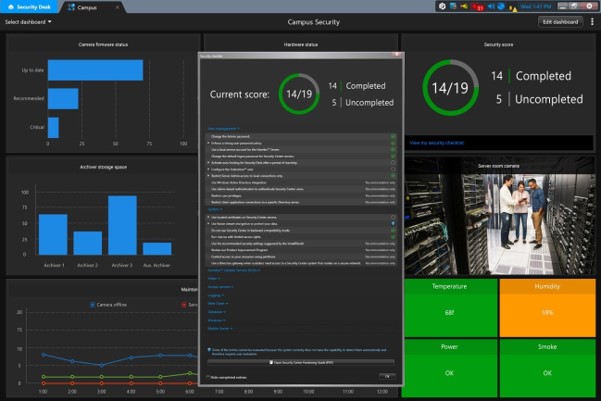
Genetec™ Streamvault™ with an Intel core set for growth in 2020 and beyond
 By Chris Cubbage, CPP, CISA, GAICD, Executive Editor
By Chris Cubbage, CPP, CISA, GAICD, Executive Editor
Consider the world’s technical mega-trends: the proliferation of cloud computing, the cloudification of networks, edge computing with artificial intelligence (AI), and analytical capability. Consider over half of the world’s data was created in the last two years and less than 2 per cent of that data has been analysed.[1] Increased compute demand and diversifying workloads are driving growth and applications of AI, high-performance computing (HPC), multi cloud computing and orchestration, networks, databases, virtualisation and cyber- security.
Higher compute performance and lower network latency is overlayed by the biggest trend of them all – the decreasing cost of computing. In just five years, between 2012 and 2017, the cost of storage plummeted 77 per cent and compute costs dropped 56 per cent. While in the same period, computer processing performance increased a whopping 370 per cent.
Data processing is rapidly moving from descriptive and diagnostic analytics to predictive analytics, giving foresight; prescriptive analytics, for simulation-driven, improved decision making; and cognitive analytics, with self-learning and automated action capability.
The transition from operational to advanced analytics will overcome bandwidth limitations and storage costs by the analytics processing moving to the network edge. This delivers near real time response needs, from what has been a forensic and review application to now more predictive and cognitive application. This shift also creates greater accuracy and addresses privacy concerns, with less data moving around vulnerable networks. For video analytics, systems are now achieving 97 per cent identification accuracy, which is better than any human can sustain in an operations room.
 HPC technology is giving rise to high performance video systems. The digital video landscape will contribute 82 per cent of all IP traffic by 2021 and security video will naturally be a big part of that. By 2025 deep learning revenue is forecast to be worth $40 billion and growing at 11 per cent CAGR (calendar annual growth rate)[2]. Deep learning enabled video systems and NVRs (network video recorders) have many use cases, such as public surveillance, transport monitoring, crowd monitoring, region of interest detection and intrusion detection. Market verticals are vast; across cities, financial services, robotics and drones, home, retail, and health services.
HPC technology is giving rise to high performance video systems. The digital video landscape will contribute 82 per cent of all IP traffic by 2021 and security video will naturally be a big part of that. By 2025 deep learning revenue is forecast to be worth $40 billion and growing at 11 per cent CAGR (calendar annual growth rate)[2]. Deep learning enabled video systems and NVRs (network video recorders) have many use cases, such as public surveillance, transport monitoring, crowd monitoring, region of interest detection and intrusion detection. Market verticals are vast; across cities, financial services, robotics and drones, home, retail, and health services.
Cloud proliferation is happening and data analytics is a strategic business tool with an ability to create value from predictive insights. As of 2020, the emerging 5G networks will begin to connect billions of devices and the cost of compute and storage will continue to drop, dramatically. With digital video driving much of the IP traffic, the opportunities for video analytics are endless.
Intel’s product portfolio spans the spectrum from edge to datacentre and cloud, including a large eco-system of developers and development tools that share common algorithms across the portfolio which can significantly speed up development cycles.
It is therefore not a coincidence that Genetec is converging its software with hardware from the likes of Intel and Dell Technologies, creating new product series like that of the Streamvault portfolio. Intel technologies can be found across the stack from smart edge devices with analytics capabilities enabled by the Movidius VPU, through to gateways, cloud and Datacenter servers and appliances built on high performance 2nd Generation Xeon processors
Optimising the software stack and deploying capabilities on modern hardware can have a profound effect on overall solution performance and throughput. For example, by utilising modern Intel technologies and the Intel distribution of OpenVino, Philips was able to achieve a 38X increase in image throughput on x-ray analysis, and GE saw a 14x improvement in inferencing speed over their baseline solution with a clinical diagnostic scanning implementation. The combination of OpenVino and 2nd generation Intel Xeon processors mean developers do not require expensive third-party accelerators to enable high performance video analytics.
Genetec has been in business 22 years and their video systems are generating 15,000 petabytes (PB) of data. Having the ability to granularly analyse all of this data is clearly a business enabler. The R&D focus is becoming “how do we dig into the data our systems are collecting,” said Philippe Ouimette, Director of Strategic Partnerships, Genetec. Hence why, again, it makes sense for Genetec to be working with Intel and Dell Technologies.
Daniel Corney, Solution Architect – Industry IoT, Surveillance and Computer Vision, APJC, Dell Technologies, walked through the Poweredge R740xd2 enterprise content server, which is the platform on which Streamvault operates. Built to provide scalable business architecture, with flexible internal storage, intelligent automation, and integrated security, the features include targeted workloads for media streaming (video surveillance and content delivery networks), Microsoft Exchange Mailbox and software-defined storage (like WSSD or vSAN).
Corney highlighted the ability to scale up to 416TB in a 2U with cost-effective internal storage and scale-out to 7.2PB in a 42U rack. This allows the management of thousands of hours of videos or Exchange mailboxes in one location and as a streamlined server, and comes with intelligent automation and integrated security.
The Dell EMC VxRail design principles provides turnkey experience, lifecycle experience and highly differentiated for full stack integration, networking automation, and advanced analytics. The VxRail comes with the iDRAC9 controller for agent free embedded server management and the OpenManage application to manage, patch and monitor server fleets. The cybersecurity approach is based on NIST guidelines to develop the Cyber Resilient Architecture, starting with silicon roots of trust and end to end supply chain assurance. There is a BIOS and iDRAC9 dual authentication to verify system integrity.
Genetec has thought strategically about the business proposition for integrators. This protection and verification extends security across the server ecosystem and thereby the supply chain, proposing to be the world’s most secure server against physical intrusion. It includes multiple layers of protection aligned to the iDRAC Credential Vault and Chassis Intrusion Alert, malware injection with Dual Silicon Root-of-Trust, ‘tamper in transit’ protection with Dell EMC Supply Chain Assurance, malicious firmware update via Root-of-Trust + Cryptographically signed and validated firmware, and rogue configurations attack (back to the iDRAC) and data breach protection with system erase and user authentication.
“We’ve eliminated the need to deploy Genetec software onto hardware before installation, providing pre-configured appliances that are essentially plug and play, with cyber security baked in — potentially saving days of precious time per project,” said Ouimette. “Systems integrators and end users can deploy fully hardened systems, with automated updates based on regular testing and vigilance against threats built into the solution.”
Lee Shelford, Sales Engineer for APAC, Genetec outlined how Streamvault is designed to secure the system deployment, increase margins via reduced installation times and therefore delivers enhanced business continuity. Cybersecurity is included by default. The system’s connectivity allows monitoring and maintenance, with automatic patching. Hardening is by custom group policy, configured registry, set Windows firewalls, anti-virus, NetBIOS, forced custom passwords and verified Windows update status. Blackberry Cylance is deployed as the chosen malware detection tool and third-party penetration tests with letters of completion are also provided. Staying connected and updated includes the camera firmware, Windows updates validated by Genetec and real time notifications in the configuration tool.
The Streamvault portfolio includes 100 series to 300 series, bundled with all licences including number plate recognition and access control. The 4010e-R4-H provides Raid5 or JBOD up to 52TB and up to 570mbps on 1RU. For 4010ex – R26-H – up is suitable to 1000 cameras and 2.2gbps and 355TB based on 16TB HD and Perc740.
There is a 730 per cent performance improvement on offer over the ‘off the shelf’ hardware alternatives. This is calculated based on the standard ‘customer off the shelf’ or COTS server with 300Mbps recording and redirection and playback, all coming out of the 300Mbps. For the Streamvault, the 4011e, gives 2200Mbps, with 1300Mbps recording, 750Mbps redirection, and 150Mbps playback. For Federated systems they need to ensure systems can be redirected and have adequate throughput. This offers a 14RU to 2RU improvement or the calculated 750 per cent.
Finally, the analytics. Analytics appliances are built to run KiwiVision and working with Dell and Intel, the sva-1010e-h and Nvidia and running up to 80 video streams and the sva2000 will do up to 150 streams. Genetec has also recently announced the sharpZ3 PR mobile licence analytics with Intel Movidius myriad x VPU for high performance at the edge with deep learning capabilities. There is much more to dive into.
Over the last 18 months, Genetec reports that the transition to Streamvault in government, transport, and local government has been increasing. With a sound business case built on a trusted and security supply chain, this transition is likely to continue and is a platform all security consultants and integrators should have insight into. Not just for technical comparison but to be benchmarked against current designs and platforms on the market.
[1] https://www.domo.com/learn/data-never-sleeps-6
[2] https://www.securityinformed.com/insights/video-surveillance-data-storage-challenges-co-10817-ga-co-2851-ga-co-11453-ga.21002.html
RELATED READING – Cyber threat landscape demands more of the Security Supply Chain – From the chip to the camera







